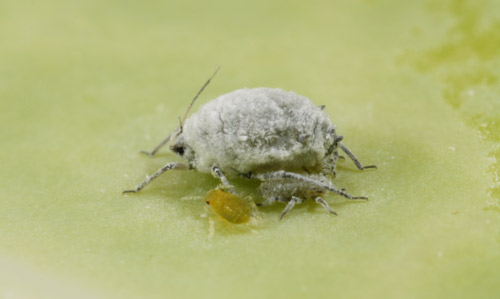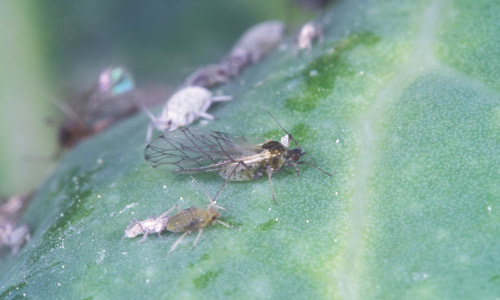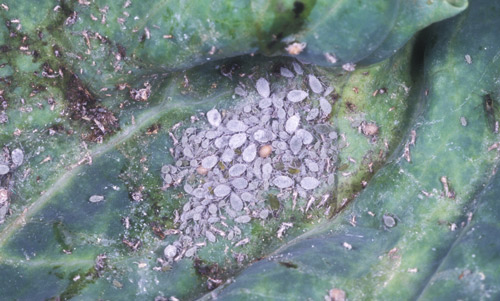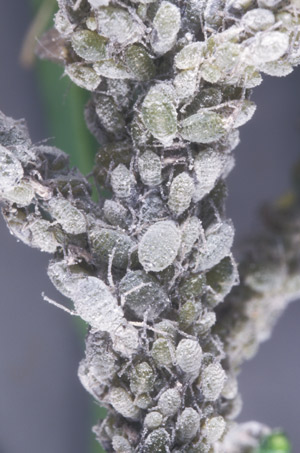common name: cabbage aphid
scientific name: Brevicoryne brassicae Linnaeus (Insecta: Hemiptera: Aphididae)
Introduction - Distribution - Identification - Hosts - Life History - Damage - Management - Selected References
Introduction (Back to Top)
The cabbage aphid belongs to the genus Brevicoryne. The name is derived from the Latin words brevi and coryne and which loosely translates as small pipes. In aphids, there are two small pipes called cornicles or siphunculi (tailpipe-like appendages) at the posterior end that can be seen if you look with a hand lens. The cornicles of the cabbage aphid are relatively shorter than those of other aphids with the exception of the turnip aphid Lipaphis erysimi (Kaltenbach). These short cornicles and the waxy coating found on cabbage aphids help differentiate cabbage aphids from other aphids that may attack the same host plant (Carter and Sorensen 2013, Opfer and McGrath 2013). Cabbage aphids cause significant yield losses to many crops of the family Brassicaceae, which includes the mustards and crucifers. It is important to have a comprehensive understanding of this pest and its associated control measures so that its spread and damage can be prevented.
Figure 1. Cabbage aphids, Brevicoryne brassicae Linnaeus, on cabbage. Photograph by Lyle Buss, University of Florida, Entomology and Nematology Department.
Distribution (Back to Top)
The cabbage aphid is native to Europe, but now has a worldwide distribution (Kessing and Mau 1991). Severe damage to various plants in the family Brassicaceae has been reported in many areas including Canada, The Netherlands, South Africa, India and China. The cabbage aphid is widely distributed throughout the U.S. and has been found to be more of a pest in the southern states (Carter and Sorensen 2013).
Identification (Back to Top)
The cabbage aphid is difficult to distinguish from the turnip aphid (Lipaphis erysimi (Kaltenbach)). The cabbage aphid is 2.0 to 2.5 mm long and covered with a grayish waxy covering, but the turnip aphid is 1.6 to 2.2 mm long and has no such covering (Carter and Sorensen 2013).
The cabbage aphid and green peach aphid (Myzus persicae (Sulzer)) can be confused when they are both found feeding on cabbage plants. However, they have distinguishing morphological characteristics. For instance, the cabbage aphid is waxy with short cornicles. On the other hand, the green peach aphid lacks a waxy covering, and has long cornicles (Opfer and McGrath 2013). Moreover, green peach aphids mainly attack cabbage before heading (after transplanting, the cabbage seedling starts producing leaves, and eventually the cabbage plant begins to produce a small, tight head at the center of the group of leaves) begins, but cabbage aphids may attack the crop at any stage (Elwakil and Mossler 2013).
Figure 2. Cabbage aphid, Brevicoryne brassicae Linnaeus, winged alate and nymphs on cabbage. Photograph by Lyle Buss, University of Florida, Entomology and Nematology Department.
Hosts (Back to Top)
The cabbage aphid has a host range restricted to plants in the family Brassicaceae (=Cruciferae), which include both cultivated and wild cruciferous crops (Gabrys et al. 1997).
Major economically important host crops where significant losses have been found include cauliflower (Brassica oleracea L. var. botrytis L.), brussels sprouts (Brassica oleracea L. var. gemmifera DC), broccoli (Brassica oleracea L. var. italica Plenck) cabbage (Brassica oleracea L.), oilseed rape (Brassica napus L.) and other members of the genus Brassica (e.g., Indian mustard (Brassica juncea L.), white mustard (Sinapis (= Brassica) alba L.), black mustard (Brassica nigra L.), toria (Brassica rapa L.). It also attacks Chinese broccoli, Chinese cabbage (Brassica rapa, subspecies pekinensis and chinensis), radish (Raphanus sativus L.) and kale (Brassica alboglabra L.H. Bailey) (Kessing and Mau 1991). Cabbage aphid is an especially big problem in broccoli and cabbage production (Opfer and McGrath 2013).
Life History (Back to Top)
Aphids can reproduce two ways. In warm climates (e.g., in Florida and Hawaii), females give birth to female nymphs without mating. In this case, an aphid colony consists of females only. This occurs during warmer periods in temperate climates as well. In temperate climates, however, the mode of reproduction changes during the autumn as temperatures begin to drop. In response to low temperature or decrease in photoperiod, males are also produced (Blackman and Eastop 1984). Mating takes place and females lay eggs. The egg stage is the overwintering stage of aphids. Generations are overlapping, with up to 15 generations during the crop season (Hines and Hutchison 2013). The total life cycle duration ranges between 16 to 50 days depending on temperature. The life cycle is shorter at higher temperatures (Kessing and Mau 1991).
Figure 3. A cabbage aphid, Brevicoryne brassicae Linnaeus, colony or cluster on a cabbage leaf. Photograph by Lyle Buss, University of Florida, Entomology and Nematology Department.
Eggs: In temperate climates, eggs overwinter in plant debris near the soil surface (Hines and Hutchison 2013). Eggs are not laid in warm climates; females produce female nymphs directly (Kessing and Mau 1991).
Nymphs: In instances where eggs are not produced, the female gives birth to nymphs. Nymphs differ from adults (including wingless adults, known as apterae) in having less developed caudae and siphunculi. The nymphal period varies from seven to ten days. Winged forms develop and start migrating to new host plants only when plant quality deteriorates or when a plant becomes overcrowded.
Adults: Aphids are soft-bodied and oval or pear shaped with a posterior pair of tubes called cornicles, which project backward. Aphids have piercing-sucking mouthparts. Adult cabbage aphids can take on two forms: winged and wingless (Herrick and Huntgate 1911). Wingless adults are 1/10 inches long, oval-shaped and appear grayish-green or grayish-white due to their waxy covering (Hines and Hutchison 2013, Natwick 2009, Opfer and McGrath 2013). On the upper abdominal surface, eight dark brown or black spots are located beneath the waxy coating. These spots increase in size toward the posterior end. Winged females are smaller and lack the waxy covering of wingless females (Natwick 2009). The wings are short with prominent veins. The head and thorax are dark brown to black with dark brown antennae. The winged aphids have a yellow abdomen with two dark spots on the dorsal anterior abdominal segments. These two spots merge into a dark band across the last abdominal segment (Kessing and Mau 1991).
Damage (Back to Top)
Aphids feed by sucking sap from their host plants. They produce a sugary waste product called honeydew, which is fed on by ants. In turn, the ants provide the aphids with protection from natural enemies. Continued feeding by aphids causes yellowing, wilting and stunting of plants (Opfer and McGrath 2013). Severely infested plants become covered with a mass of small sticky aphids (due to honeydew secretions), which can eventually lead to leaf death and decay (Griffin and Williamson 2012). Cabbage aphids feed on the underside of the leaves and on the center of the cabbage head (Hines and Hutchison 2013). They prefer feeding on young leaves and flowers and often go deep into the heads of Brussels sprouts and cabbage (Natwick 2009). Colonies of aphids are found on upper and lower leaf surfaces, in leaf folds, along the leafstalk, and near leaf axils.
Figure 4. Cabbage aphids, Brevicoryne brassicae, Linnaeus colony (or cluster) on a cabbage stem. Photograph by Lyle Buss, University of Florida, Entomology and Nematology Department.
The cabbage aphid is of agricultural concern because it is a vector of at least 20 viral pathogens that can cause diseases in crucifers and citrus. Both wingless (apterae) and winged (alate) forms are able to transmit viruses, but the wingless aphids demonstrate a higher rate of transmission (Toba 1962). The cabbage aphid’s mode of pathogen transmission is non-persistent: the aphid picks up the virus by feeding on infected plants and transfers the pathogen to healthy plants by probing with its mouthparts or feeding (Kessing and Mau 1991). Aphids cause major losses to broccoli by reducing yield, with real damage being contamination of harvested heads of broccoli (Natwick 2009, Opfer and McGrath 2013). In Oregon, contamination of some broccoli heads may lead to the rejection the entire harvest by quality assurance programs managed by broccoli processors (Opfer and McGrath 2013).
Management (Back to Top)
Aphids are serious pests under cool and dry conditions. Cultural and biological control strategies can help reduce aphid infestation and use of pesticides while still maintaining yield and quality of produce. For large scale (commercial) production, insecticide application should be considered when 2% of plants are infested with aphids. It is important to add a spreader-sticker (liquid detergent to break the surface tension of droplets) to the insecticides to increase surface contact with the waxy covering of the aphids' bodies (Griffin and Williamson 2012). If one can delay pesticide application before head formation in cole crops, it can save expenses and help to conserve natural enemy populations (Natwick 2009). For small-scale vegetable growers (home growers), aphids can be repelled by planting crops with reflective mulch-covered beds and monitored by filling yellow pans with water, if aphids are found in great numbers in the water traps additional control measures may be necessary (Griffin and Williamson 2012).
Action threshold: Fields should be scouted every week for signs of aphids (Webb 2010). In Minnesota and Florida, there is no specific threshold level for aphids on cruciferous crops, but insecticides should only be used when aphid populations are high (>50/plant) on very young seedlings/transplants up to ~7 leaf stage, or on plants close to harvest, as a contaminant or marketability precaution. Some aphid populations can be suppressed by conventional insecticides used to control Lepidopteran pests. Bacillus thuringiensis (Bt) products are not effective on aphids. However, when these products are used to control diamondback moth and imported cabbageworm (in early season), the beneficial insect complex is maintained and that usually keeps aphid population under check (Hines and Hutchison 2013, Webb 2010). In a broccoli field, you can get a sense of aphid density using the 10 by 10 method, which involves pulling 10 broccoli leaves at 10 different spots in the field, then counting the number of aphids on them. If more than 20% of leaves are infested with aphids, then an insecticide application is recommended (Opfer and McGrath 2013).
Cultural control: The field should be plowed immediately after harvest to prevent the spread of aphids to other crops (Griffin and Williamson 2012). It is important to rid the field and surrounding areas of any alternate host plants like mustards or other cruciferous weeds (Natwick 2009). Destruction of plant debris at the end of the season can help kill overwintering aphid eggs in temperate climates (Hines and Hutchison 2013). Planting a nectar plant to attract beneficial insects could also be helpful e.g., sweet alyssum (Lobularia maritima (L.) Desv.) as tested in cabbage (Webb 2010). Crop rotation with non-host crops is also beneficial (Kessing and Mau 1991). Choice of cultivar could also reduce aphid populations and damage. For example, the cauliflower cultivar ‘Smilla’ could be a good choice because it affects adult reproductive parameters (Jahan et al. 2013). Avoid replanting on land where an aphid-infested crop has been recently removed. Plant spacing is not considered as an effective approach for cabbage aphid control in canola (Brassica napus L.) crops (Razaq et al. 2012).
Biological control: Parasites and predators are important for regulating aphid populations. The parasitic wasp Diaeretiella rapae (M'Intosh) (Hymenoptera: Aphidiidae) lays eggs within half-grown nymphs (preferring 2nd to 4th instars over 1st instar nymphs and adults) and mummifies them, forming a light brown, hard shell around the aphid. Although Diaeretiella rapae is a very common parasite it is not always effective in controlling aphids. When the wasp populations are large enough to control aphids, the aphid population has usually exceeded damage thresholds. Protecting habitat that will foster the population and survival of natural enemies can help reduce the need for pesticides (Natwick 2009). Syrphid fly maggots, lady beetle adults and larvae, and lacewing larvae (aphid lions) are common predators of aphids. Seed extract of the Chinaberry tree (Melia azedarach) (Baidoo and Adam 2012, Kibrom et al. 2012, Mekuaninte et al. 2011), leaf extract of peppermint (Mentha piperita), and seeds and leaf extract of flowering lantana (Lantana camara) (Baidoo and Adam 2012) have showed promising results against cabbage aphid (Mekuaninte et al. 2011).
Chemical control: Many insecticides are effective against aphids. Care must be taken that sprays thoroughly wet the plants, because of the waxy nature of the pest and crop. To achieve maximum control with minimum efforts, proper surfactant proportions in combination with well-adjusted spray equipment are important (Kessing and Mau 1991). Aphids have been managed using insecticidal soaps (e.g. Safer Soap). Application timing is very important to keep aphids under control while conserving populations of natural enemies (Griffin and Williamson 2012, Hines and Hutchison 2013). A study on insecticide resistance in cabbage aphid carried out in Pakistan reports that aphids developed resistance to chemicals including methomyl, emamectin benzoate, and pyrethroids (cypermethrin, lambdacyhalothrin, bifenthrin and deltamethrin) and neonicotinoids (imidacloprid, acetamiprid, and thiamethoxam). Their resistance level was also found to increase progressively in concurrence with regular use on vegetables (Ahmad and Akhtar 2013).
Selected References (Back to Top)
- Ahmad M, Akhtar S. 2013. Development of insecticide resistance in field populations of Brevicoryne brassicae (Hemiptera: Aphididae) in Pakistan. Journal of Economic Entomology 106: 954-958.
- Baidoo PK, Adam JI. 2012. The effects of extracts of Lantana camara (L.) and Azadirachta indica (A. Juss) on the population dynamics of Plutella xylostella, Brevicoryne brassicae and Hellula undalis on cabbage. Sustainable Agriculture Research 1: 229-234.
- Beirne BP 1972. Pest insects of annual crop plants in Canada. IV. Hemiptera-Homoptera V. Orthoptera VI. Other groups. Memoirs of the Entomological Society of Canada 85. 73 pp.
- Blackman RL, Eastop VF. 1984. Aphids on the world’s crops. An identification and information guide. John Wiley J.
- Carter CC, Sorensen KA. 2013. Insect and related pests of vegetables. Cabbage and turnip aphid. Center for Integrated Pest Management. North Carolina State University, Raleigh, NC. (5 September 2019)
- Elwakil WM, Mossler, M. 2013. Florida crop/pest management profile: Cabbage. Agronomy Department, Florida Cooperative Extension Service, IFAS, University of Florida, Gainesville, FL. (5 September 2019)
- Gabrys BJ, Gadomski HJ, Klukowski Z, Pickett JA, Sobota GT, Wadhams LJ, Woodcock CM. 1997. Sex pheromone of cabbage aphid Brevicoryne brassicae: identification and field trapping of male aphids and parasitoids. Journal of Chemical Ecology 23: 1881-1890.
- Griffin RP, Williamson J. 2012. Cabbage, Broccoli & Other Cole Crop Insect Pests. HGIC 2203, Home & Garden Information Center. Clemson Cooperative Extension. Clemson University, Clemson, SC. (5 September 2019)
- Herrick GW, Hungate JW. 1911. The cabbage aphid. New York (Cornell) Agricultural Experiment Station Bulletin. 300: 715-746.
- Hines RL, Hutchison WD. 2013. Cabbage aphids. VegEdge, vegetable IPM resource for the Midwest. University of Minnesota, Minneapolis, MN. (2 October 2013)
- Jahan F, Abbasipour H, Askarianzade A, Hasanshahi G, Saeedizadeh A. 2013. Effect of eight cauliflower cultivars on biological parameters of the cabbage aphid, Brevicoryne brassicae (L.) (Hem: Aphididae) in laboratory conditions. Archives of Phytopathology and Plant Protection 46: 636-642.
- Kessing JLM, Mau RFL. 1991. Cabbage aphid, Brevicoryne brassicae (Linnaeus). Crop Knowledge Master. Department of Entomology, Honolulu, Hawaii. (5 September 2019)
- Kibrom G, Kebede K, Weldehaweria G, Dejen G. Mekonen S. Gebreegziabher E. Nagappan R. 2012. Field evaluation of aqueous extract of Melia azedarach Linn. seeds against cabbage aphid, Brevicoryne brassicae Linn. (Homoptera: Aphididae), and its predator Coccinella septempunctata Linn. (Coleoptera: Coccinellidae). Archives of Phytopathology and Plant Protection 45: 1273-1279.
- Mekuaninte B, Yemataw A, Alemseged T, Nagappan R. 2011. Efficacy of Melia azadarach and Mentha piperata plant extracts against cabbage aphid, Brevicoryne brassicae (Homoptera: Aphididae). World Applied Science Journal 12: 2150-2154.
- Moon MS. 1967. Phagostimulation of a monophagous aphid. Oikos 18: 96-101.
- Natwick ET. 2009. Cole crops: Cabbage aphid. UC Pest Management Guidelines. University of California Agriculture & Natural Resources. (5 September 2019)
- Opfer P, McGrath D. 2013. Oregon vegetables, cabbage aphid and green peach aphid. Department of Horticulture. Oregon State University, Corvallis, OR. (2 October 2013)
- Palmer, MA. 1952. Aphids of the Rocky Mountain region. Thomas Say Foundation, Vol. 5. 452 pp.
- Razaq M, Maqsood S, Aslam M, Shad SA, Afzal M. 2012. Effect of plant spacing on aphid population, yield components and oil contents of late sown canola, Brassica napus L. (Brassicaceae). Pakistan Journal of Zoology 44: 991-995.
- Toba HH. 1962. Studies on the host range of watermelon mosaic virus in Hawaii. Plant Disease 46: 409-410.
- Webb SE. 2010. Insect management for crucifers (cole crops) (broccoli, cabbage, cauliflower, collards, kale, mustard, radishes, turnips) ENY-464. Entomology and Nematology Department, Florida Cooperative Extension Service, IFAS, University of Florida, Gainesville, FL. (5 September 2019)
Acknowledgements: Special thanks to Morgan Conn, Dr. Susan Webb, Dr. John Capinera and Dr. Howard Frank for their review of this document.



